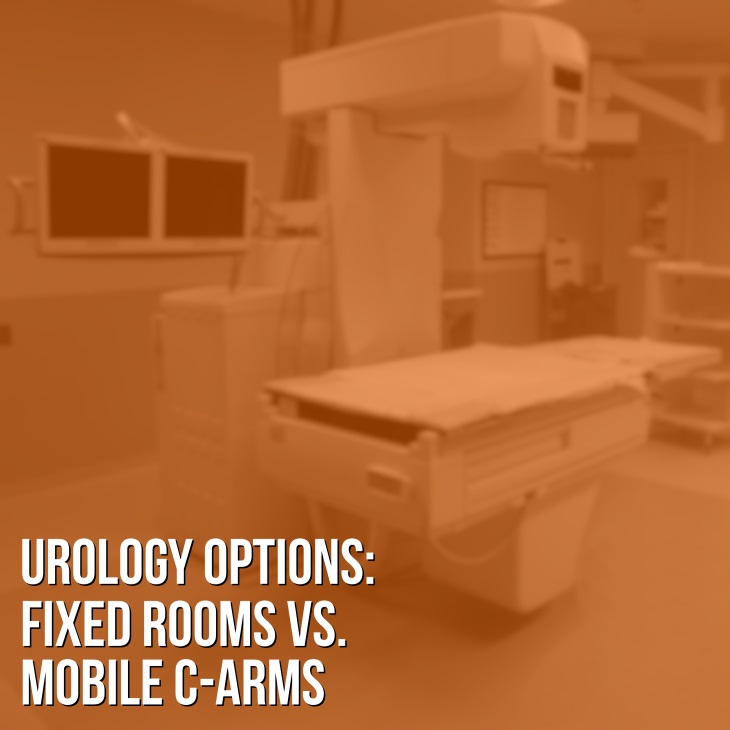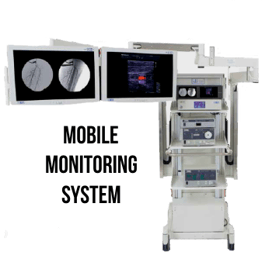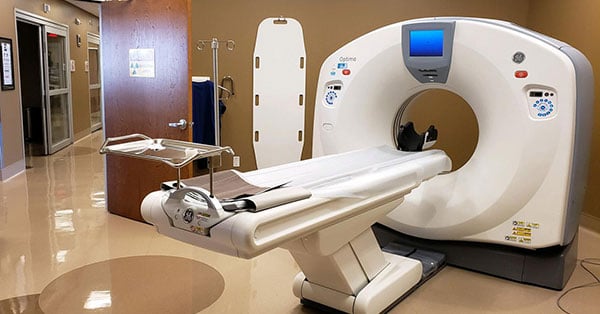
When it comes to imaging equipment, today's urologist has options. Specifically: a mobile C-arm and surgical table with a monitoring system, or a dedicated, fixed urology suite.
There isn't a "right" answer when it comes to this decision- both options have their pros and cons- but, depending on the needs at your individual facility, there probably is a "best" answer.
If you could use a little clarity on the subject, the following are some of the major pros and cons, comparing the use of either a mobile C-arm and table with monitoring, or a fixed suite for your urology practice.
Mobile Urology Setup: C-arm, Table, Monitoring System
Pros:
Adding a C-arm, mobile surgical table, and monitoring system to your facility will require no remodeling. Nothing is anchored to the floor, there are no power requirements beyond a standard outlet, and the overall footprint of the setup is relatively low.
The system can be used for many other applications besides urology. If your facility does more than just urology, a room with this setup in it offers flexibility for other specialists in the building.
 The monitoring system gives mobile setups performance similar to those of fixed units and flexibility above and beyond. You can run almost any video signal into these monitors for use anywhere.
The monitoring system gives mobile setups performance similar to those of fixed units and flexibility above and beyond. You can run almost any video signal into these monitors for use anywhere.
A mobile urology setup costs significantly less than a fixed suite. How much less will depend largely on which model of C-arm you're considering.
Cons:
Switching from patient to patient or from doctor to doctor is clumsier with a mobile setup. With three pieces on wheels, two sets of foot controls and more exposed cabling, the freedom of movement comes at the price of some awkwardness.
Unless you invest in a bariatric-grade table, most mobile surgical tables have a maximum weight capacity of 450 pounds. This will, of course, suffice for the majority of patients, but could be a hindrance in select circumstances.
Fixed Urology System
Pros:
Due to their larger image intensifiers (16" vs. 13" in the largest C-arms), fixed urology systems offer a larger field of view than mobile C-arms.
Fixed systems also have more powerful generators at 65 kilowatts, versus 25 in the largest c-arms. This enables urologists to do longer studies on bigger patients. Another aspect of fixed systems that comes in handy for bigger patients is the higher weight capacity of the tables. The average rating is around 600 pounds.
With all of the components integrated together, a single set of foot controls, and many of the cables concealed, adjusting a fixed system between procedures can be much smoother. This integrated, single-piece style is also a format that many experienced urologists are more familiar and comfortable with.
Cons:
A fixed urology system will cost you more than a mobile setup. Not only is this true in terms of the equipment, but also in the remodeling and installation that will be necessary to get your fixed room up and running.
This type of equipment is very well suited to urological procedures, but not really cut out for other specialties. Count on urologists, and urologists only, using these systems.
Unlike C-arm buyers, those shopping for fixed urology systems have very limited choices in terms of manufacturers. Currently, there are only two major players making new urology rooms: Siemens and Liebel-Flarsheim. These are well-made systems but, due to their single-purpose nature, they don’t hold their value as well as C-arms in the secondary market.
The Takeaway
Based on our experience with people looking for a great urology setup:
Buy a fixed system if you plan to focus on urology or if the urology volume at your facility will be very high. Fixed systems are also a better choice if power and throughput are priorities.
Buy a mobile C-arm setup if your facility has more moderate urology volume and could use the C-arm's flexibility to perform in other specialties. The C-arm setup is also a better option if you're operating on a tighter budget.
As we said earlier, there isn't really a "right" answer here , but hopefully you've gained some perspective on what your "best" answer is. To learn more, or take the next step, contact us here for questions or quotes.

Chris Sharrock
Chris Sharrock is the Vice President of Healthcare Solutions at Block Imaging. Each day Chris sets out to provide the best equipment, parts, and service solutions for healthcare facilities across the world. Outside of work Chris enjoys playing in a band, and spending time at the lake with his family.






